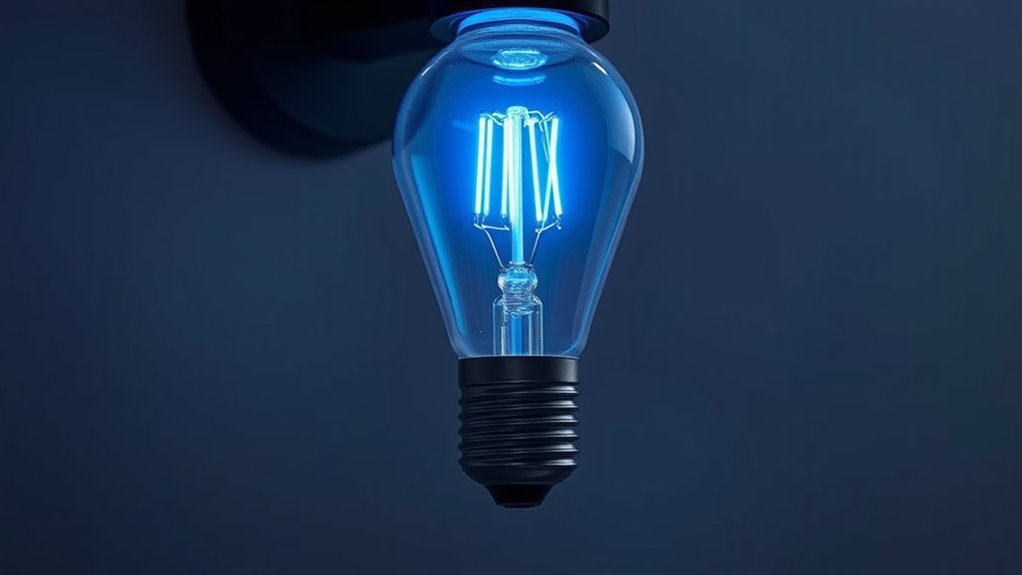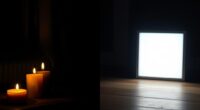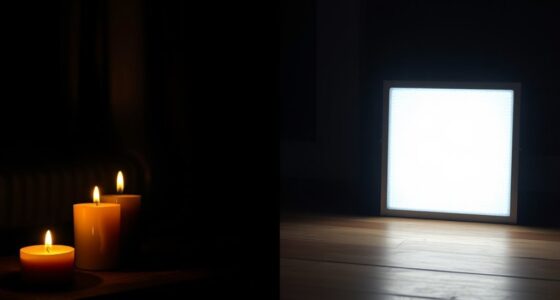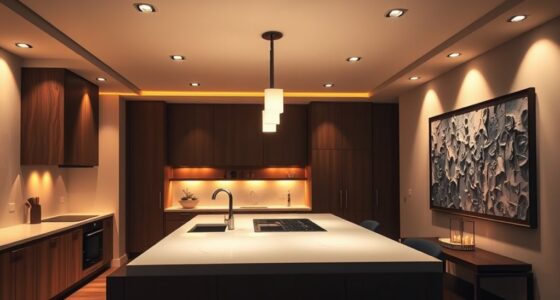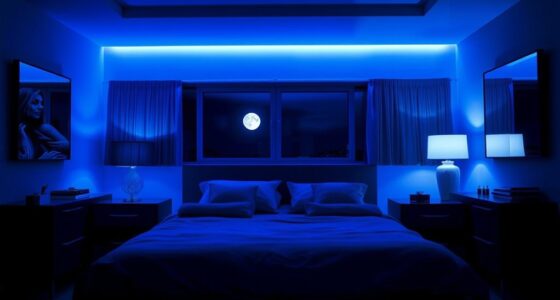High-tech smart bulbs can help you sleep better by adjusting color temperature and brightness to mimic natural light cycles. They reduce blue light exposure at night, promote melatonin production, and sync with your sleep patterns. Features like gradual dimming and sunrise mimicking can create a calming environment that supports your circadian rhythm. If you want to discover how these innovative bulbs can transform your sleep routine, keep exploring the benefits and setup tips.
Key Takeaways
- High-tech bulbs adjust color temperature and brightness to align with natural circadian rhythms, promoting better sleep.
- They feature gradual dimming and sunrise simulations that encourage melatonin production and easier sleep onset.
- These smart bulbs minimize blue light exposure in the evening, reducing sleep cycle disruption.
- Integration with routines and automation helps maintain consistent sleep-wake schedules.
- User feedback highlights improved sleep quality, fewer wake-ups, and enhanced overall health with these advanced lighting solutions.
How Light Affects Your Sleep Cycle

Light plays a crucial role in regulating your sleep cycle because it influences your body’s internal clock, known as the circadian rhythm. When you’re exposed to bright light at night, it can cause melatonin suppression, making it harder to fall asleep. This disruption is often worsened by light pollution from streetlights, screens, and other sources that extend natural daylight. The presence of artificial light during evening hours tricks your body into thinking it’s daytime, delaying melatonin production. As a result, your sleep quality suffers, and you may feel more tired during the day. Managing light exposure, especially in the evening, helps your circadian rhythm stay in sync, supporting better sleep and overall health. Understanding the impact of light pollution on sleep can help you make better choices about your environment.
The Science Behind Circadian Rhythms

Your body’s internal clock, known as the circadian rhythm, governs many physiological processes, including sleep-wake cycles, hormone release, and body temperature. It’s synchronized primarily by light exposure, especially the light spectrum you encounter daily. When exposed to natural light in the morning, your circadian rhythm promotes alertness, while darkness signals your body to prepare for sleep. Melatonin regulation plays a key role here; light suppresses melatonin, the hormone that makes you feel sleepy. Conversely, dim or red light allows melatonin levels to rise, helping you fall asleep. Modern light sources can influence this process by mimicking natural light spectrum patterns, supporting your circadian rhythm. Additionally, light exposure patterns can significantly impact your sleep quality and overall health. Understanding this science helps explain why controlling light exposure can improve your sleep quality.
Features of Modern Sleep-Optimizing Bulbs

Modern sleep-optimizing bulbs come with adjustable color temperature, so you can set the perfect light for different times of the day. They also feature smart scheduling capabilities, allowing you to automate lighting changes to support your sleep cycle. These features work together to create a healthier, more restful environment for you. Incorporating sustainable lighting options can further enhance your commitment to eco-friendly living while improving your sleep environment.
Adjustable Color Temperature
Adjustable color temperature is a key feature that allows you to tailor your lighting to support better sleep. By modifying the color temperature, you can shift the light from cool to warm tones, aiding your body’s natural circadian rhythm. This light modulation helps you relax in the evening and prepares your body for sleep, reducing exposure to blue light that can interfere with melatonin production. Here’s a visual guide:
| Color Temperature | Effect on Sleep | Best Use Timing |
|---|---|---|
| 2700K – 3000K | Warm, relaxing | Evening, bedtime |
| 3500K – 4000K | Neutral, balanced | Late afternoon |
| 5000K+ | Cool, alerting | Daytime, work |
This flexibility ensures your lighting supports your sleep cycle naturally.
Smart Scheduling Capabilities
Smart scheduling capabilities allow you to automate your lighting to align with your sleep patterns, helping you wind down and wake up more naturally. With this feature, you can set your bulb to gradually dim in the evening, creating a calming environment that supports good sleep hygiene. Imagine:
- The lights softly fading, mimicking sunset, signaling your body it’s time to relax.
- A gentle wake-up cycle that gradually brightens your room, easing you into the day.
- Customized lighting design that adapts to your routine, reducing disruptions and promoting consistent sleep.
These schedules help reinforce your sleep hygiene habits by making your lighting work with your biological clock. Additionally, integrating color temperature adjustments can further optimize your environment, making it easier to fall asleep and wake up refreshed, knowing your lighting is supporting a healthier, more natural sleep cycle.
How These Bulbs Mimic Natural Light
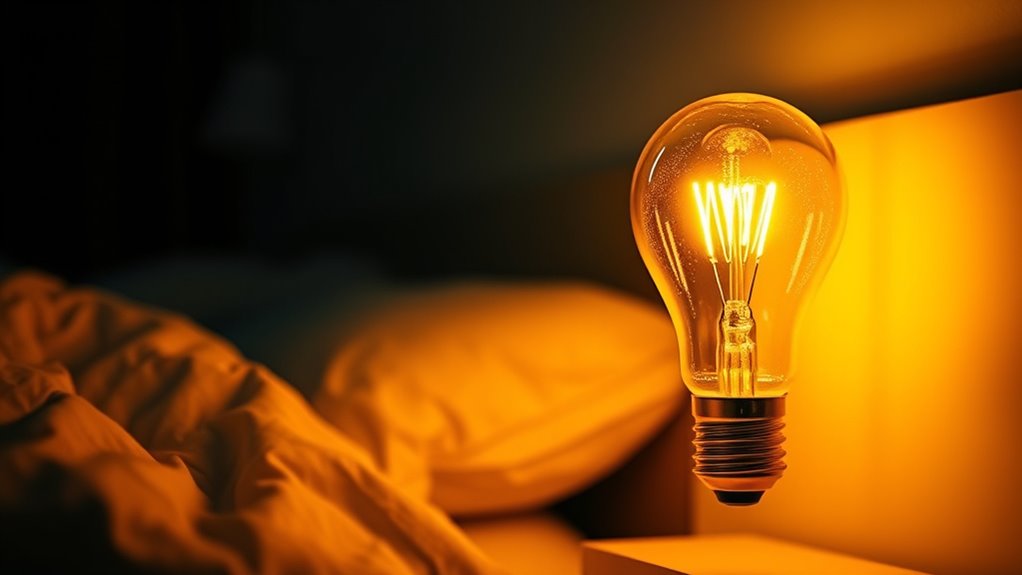
These bulbs adjust their light to match the natural day-night cycle, helping you stay in sync with your body’s internal clock. By dynamically changing brightness and color temperature, they mimic sunlight at different times of the day. This alignment supports your circadian rhythm and promotes better sleep. Incorporating organic and natural lighting options can further enhance your sleep environment and overall well-being.
Circadian Rhythm Alignment
Have you ever wondered how light influences your body’s internal clock? These smart bulbs mimic natural light by adjusting two key factors: color temperature and light intensity. Imagine the morning sun rising with a warm, bright glow that gradually shifts to a softer, cooler hue as evening approaches. When your bulb mimics this, it:
- Starts with a high light intensity and warm color temperature at dawn
- Gradually dims while shifting to cooler tones during the day
- Softens further with a warmer hue, signaling your body to wind down
- Incorporating vertical storage solutions can help keep your space organized and support a clutter-free environment that complements your sleep routine
This alignment helps synchronize your circadian rhythm, reinforcing your natural sleep-wake cycle. By carefully mimicking natural light patterns, these bulbs support your body’s internal clock, making it easier to fall asleep and wake refreshed.
Dynamic Light Adjustment
By actively adjusting both light intensity and color temperature throughout the day, high-tech light bulbs effectively mimic natural sunlight patterns. As the day progresses, the bulb increases light intensity, providing bright, energizing light that boosts alertness. Later, it shifts the color temperature to warmer tones, reducing blue light and creating a calming atmosphere. This dynamic light adjustment helps your body recognize when to be alert and when to wind down, aligning with your circadian rhythm. By simulating the natural fluctuations of sunlight, these bulbs support your sleep-wake cycle and improve overall well-being. Incorporating personalized lighting settings can further optimize your daily light exposure for better health. The seamless progression in light intensity and color temperature makes it easier for you to stay productive during the day and relax at night.
Setting Up Your Smart Lighting System

Setting up your smart lighting system begins with choosing the right hub or app that’s compatible with your bulbs. Once selected, you’ll connect your devices seamlessly, ensuring smooth control over your lighting environment. As you set up, consider these steps:
- Place your bulbs strategically to minimize light pollution, avoiding direct light into neighbors’ windows or outdoor spaces.
- Configure timers and dimming features to optimize energy efficiency, reducing unnecessary power use.
- Sync your lights with your routines to gradually adjust brightness and color temperature, aligning with your sleep cycle.
- Consider how your lighting setup can be influenced by lighting modifications such as color adjustments and placement to create a more relaxing atmosphere.
This setup helps you create a calming environment that promotes better sleep, all while reducing light pollution and conserving energy. Proper configuration is key to maximizing your smart lighting’s benefits.
Benefits Beyond Sleep Improvement
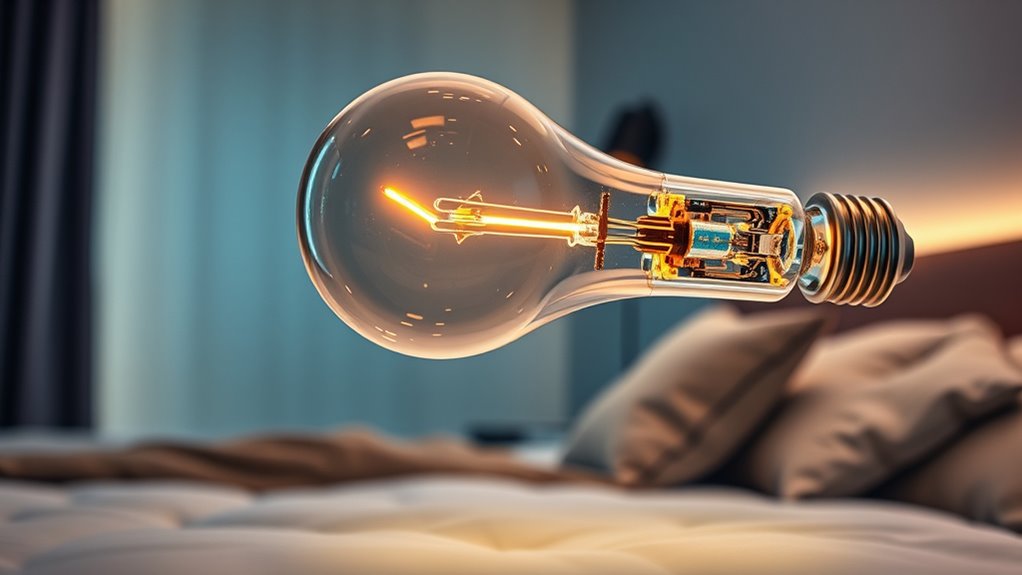
Smart lighting systems not only enhance your sleep quality but also offer a range of benefits that improve your daily life. By adjusting your lighting to reduce unnecessary brightness at night, you can minimize light pollution, helping preserve your environment and maintain natural circadian rhythms. These systems are energy-efficient, consuming less power than traditional bulbs, which lowers your energy bills and reduces your carbon footprint. You gain greater control over your lighting environment, making it easier to create a comfortable, functional space during the day and a tranquil one at night. Additionally, smart bulbs can be programmed to turn off automatically, preventing waste and promoting eco-friendly habits. Incorporating energy-efficient lighting into your home can significantly impact your overall sustainability. Overall, investing in smart lighting benefits your health, wallet, and the planet.
Comparing Traditional and High-Tech Bulbs

Traditional bulbs have long been the standard for lighting, but high-tech options now offer significant advantages. Unlike incandescent bulbs that emit harsh, yellowish light, smart bulbs can adjust color temperature, reducing blue light exposure at night. Imagine a bulb that:
- Dims gradually, mimicking sunset, to promote melatonin production
- Emits less blue light, lowering the risk of disrupting sleep cycles
- Uses energy efficiently, cutting electricity bills and light pollution
- Incorporate expert voice actors to elevate their performance and credibility
These features help minimize light pollution, making your environment calmer and more natural at night. Plus, high-tech bulbs consume far less energy than traditional ones, making them better for your wallet and the planet. When comparing the two, the benefits of high-tech lighting become clear, especially for better sleep and sustainability.
Real User Experiences and Testimonials
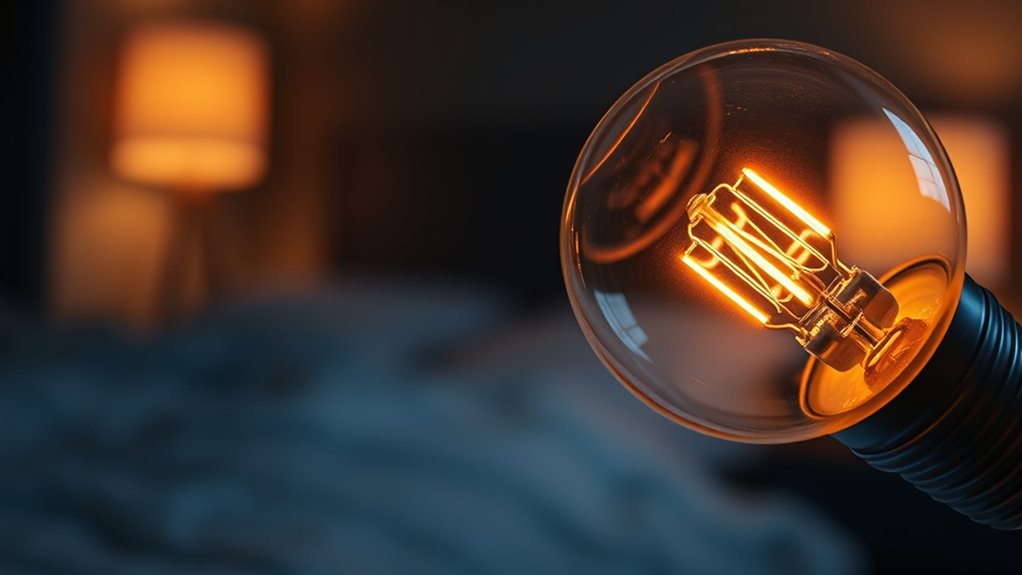
Many users have reported noticeable improvements in their sleep quality after switching to high-tech light bulbs. They mention feeling more rested and experiencing fewer wake-ups during the night. These bulbs reduce light pollution at night, creating a calmer environment that promotes melatonin production. Plus, their energy efficiency means you can enjoy better sleep without increasing your electricity bills.
| User Experience | Feedback Summary |
|---|---|
| Better Sleep Quality | Users feel more refreshed in the morning |
| Reduced Light Pollution | Softer, more natural lighting at night |
| Lower Energy Costs | Save on electricity bills |
| Improved Well-being | Less stress and better overall health |
These testimonials show that high-tech lighting truly makes a difference in your sleep and environment.
Tips for Integrating Sleep-Friendly Lighting
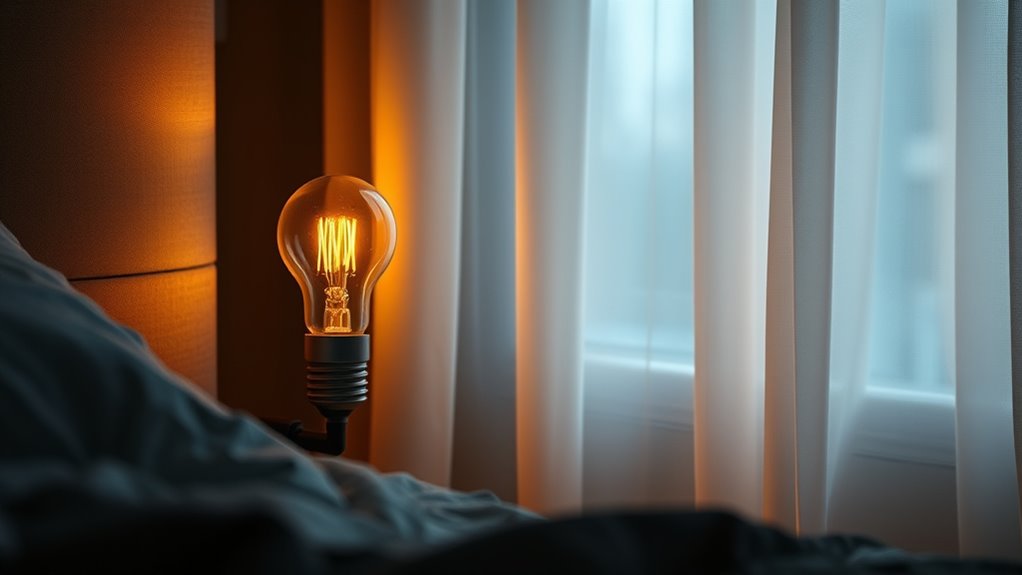
To create a sleep-friendly environment, start by choosing high-tech light bulbs that mimic natural light patterns and gradually dim in the evening. This minimizes light pollution, helping your body produce melatonin naturally. To integrate these bulbs effectively, consider these tips:
- Install warm, dimmable lights in bedrooms and hallways to reduce harsh brightness before bed.
- Use energy-efficient bulbs to cut down on electricity and lessen environmental impact.
- Set a consistent lighting schedule that aligns with sunset and sunrise, creating a natural rhythm for your circadian cycle.
Future Developments in Sleep-Enhancing Technology
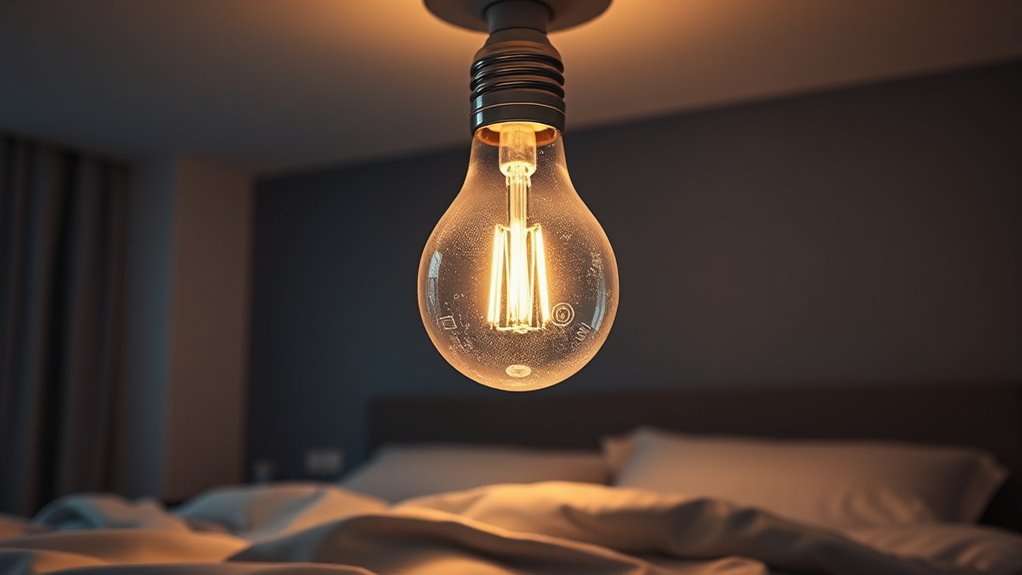
Future advancements will make sleep technology even smarter and more personalized. You can expect lighting systems that adapt automatically to your sleep patterns, improving rest without extra effort. Personalized light therapy will target your specific needs, helping you fall asleep faster and wake up refreshed.
Smart Sleep Integration
Smart sleep integration is poised to revolutionize how you optimize your rest by seamlessly connecting lighting, wearables, and home automation. Imagine your smart system adjusting your bedroom’s lighting to reduce light pollution and boost energy efficiency as you wind down. You might see:
- Your light bulbs dim gradually, syncing with your sleep cycle.
- Wearables communicate with your smart home to monitor your sleep quality.
- Automated blinds lower, minimizing external light and noise.
This interconnected setup ensures your environment adapts in real-time, creating ideal conditions for deep sleep. It also promotes energy efficiency by conserving power when full lighting isn’t needed. As technology advances, your home will become a personalized sleep sanctuary, effortlessly supporting your rest while reducing environmental impact.
Personalized Light Therapy
Building on the seamless integration of your sleep environment, personalized light therapy takes customization a step further by tailoring light exposure to your unique needs. It adjusts both color temperature and light intensity throughout the day to optimize your circadian rhythm. In the morning, it mimics natural sunlight with brighter, cooler light to boost alertness. As evening approaches, it shifts to warmer, dimmer light to signal your body to prepare for sleep. This dynamic adjustment helps regulate your sleep-wake cycle more effectively than static lighting. By personalizing these settings, you can experience better sleep quality and daytime alertness. The technology learns your patterns and adapts over time, ensuring that your light exposure supports your individual sleep needs seamlessly.
Frequently Asked Questions
Can These Bulbs Help With Seasonal Affective Disorder (SAD)?
If you’re wondering whether these bulbs can help with seasonal affective disorder, the answer is yes. They work through light therapy, mimicking natural sunlight, which can boost your mood and reduce SAD symptoms. Using these bulbs regularly can lead to mood improvement, especially during darker months. Just guarantee you follow the recommended exposure times for the best results, and consider consulting a healthcare professional for personalized advice.
Are Sleep-Boosting Bulbs Energy-Efficient and Environmentally Friendly?
You’ll find that sleep-boosting bulbs are often energy-efficient and eco-friendly lighting options. They use LED longevity technology, which consumes less power and lasts longer than traditional bulbs, reducing waste and energy use. By choosing these bulbs, you’re supporting environmentally friendly lighting practices, saving money on electricity bills, and reducing your carbon footprint. So, investing in such lighting benefits both your sleep quality and the planet.
How Long Do These Smart Bulbs Typically Last?
Smart bulbs generally last between 15,000 to 25,000 hours, depending on the brand and usage. During durability testing, manufacturers often verify their bulb lifespan to guarantee reliability over time. You can expect these bulbs to perform well for several years with moderate use. Proper handling and avoiding power surges help maintain their durability, so you get the most out of your investment and enjoy consistent lighting for a long period.
Are There Potential Health Risks With Using High-Tech Sleep Bulbs?
You might worry about health risks from using high-tech sleep bulbs, especially regarding eye strain from prolonged blue light exposure. While these bulbs are designed to promote better sleep, too much blue light can disrupt your circadian rhythm and cause discomfort. To minimize risks, use them at appropriate brightness levels and consider blue light filters. Moderation helps you enjoy the benefits without risking eye strain or other health issues.
Can These Bulbs Be Integrated With Existing Smart Home Systems?
You can definitely integrate these high-tech sleep bulbs with your existing smart home system. Most models offer smart home compatibility, allowing you to control them via apps or voice commands. However, check for compatibility issues beforehand, as some bulbs may not work seamlessly with your current setup. Ensuring compatibility helps you enjoy smooth smart home integration and simplifies managing your sleep environment effortlessly.
Conclusion
By upgrading to sleep-optimizing bulbs, you can improve your sleep quality and wake up refreshed. Did you know that poor sleep affects over 70% of adults? With smart lighting that mimics natural light, you’re taking control of your circadian rhythm and creating a healthier bedtime environment. So, why not give these high-tech bulbs a try? They’re a simple step toward better sleep and brighter mornings.
